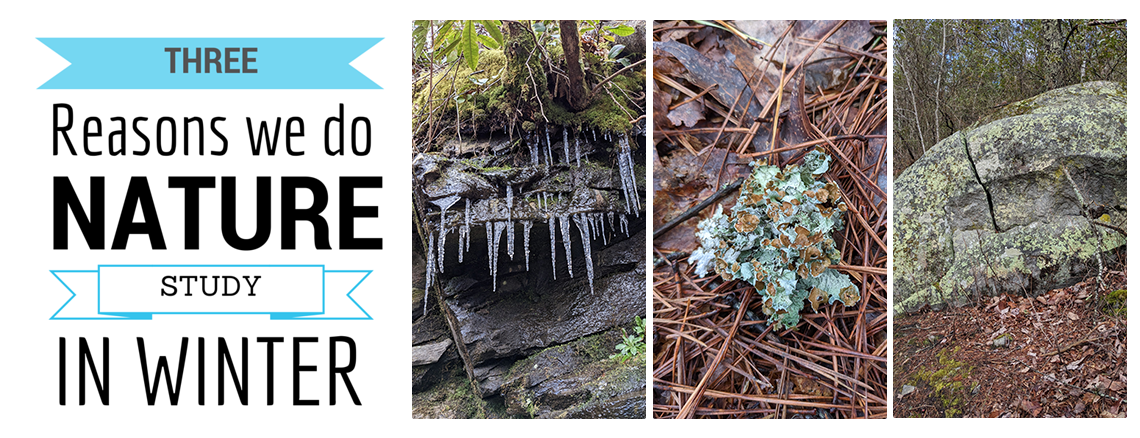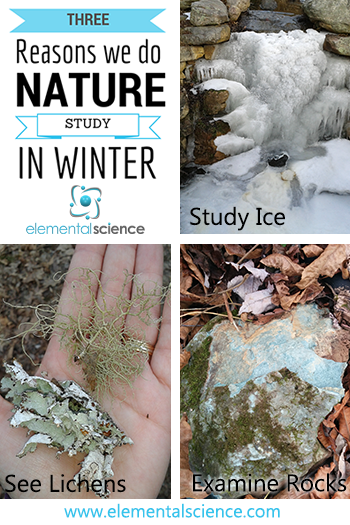FREE Shipping on all our products! (Please Note: Orders may experience a delay of a week or more in shipping due to the high volume of orders at this time of year.)
FREE Shipping on all our products! (Please Note: Orders may experience a delay of a week or more in shipping due to the high volume of orders at this time of year.)
3 Reasons We Continue To Do Nature Study During the Winter Months
December 04, 2023 2 min read

We have shared often about how nature study is a great way to make science real and practical. In our homeschool, we lean towards doing impromptu nature study while we are already enjoying the outdoors. But as the weather turns colder should you bother with continuing to do nature study?
This month, I thought we'd share three subjects that make us bundle up and brave the temps for winter nature study!
3 Reasons We Continue To Do Nature Study During the Winter Months
Of course, taking a look at the evergreen plants in your backyard is an excellent winter nature study idea, but I want to highlight three more winter nature study subjects.
#1 – YOU CAN STUDY ICE.
Often it is cold enough in the winter for the water outdoors to freeze, which means you have plenty of ice to study! You can look at when the ice freezes and how the ice appears to take up more room than the water did.
You can look at the destructive power of ice by watching the freeze-thaw cycle in action. You can see how salt affects the ice. As the winter comes to a close, you can examine how quickly the ice melts and where all that water goes.
You have to deal with the freezing temps to study ice, but it is worth see the solid state of water up close and personal.
#2 – YOU CAN EASILY SEE LICHENS.
Lichen is amazing example of a living biological partnership between a fungus and a bacteria. The fungus protects the bacteria underneath and the bacteria provides the fungus with the food it needs to grow.
With most of the foliage gone it is much easier to find patches of lichens on the tree trunks. Most of these patches are crustose lichen, but you may find some foliose lichen as well.
You can also examine fallen branches on the forest floor as well as rocks. Both of these usually contain one or more of the three different types of lichens.
#3 – YOU CAN EXAMINE ROCKS CLOSE UP.
With no flowers and few leaves to study in the winter, rocks make a perfect winter nature study subject. You can hunt for the three major types of rock in your backyard.
You can compare the different colors and discuss the minerals that in the rocks that produced the color. For example, copper in a rock might cause it to have a blue or green hue. Iron can cause a dark red or brown tint, while manganese can cause the rock to be pinkish.
However you choose to study rocks, they are plentiful and accessible during the winter months.
FINAL PRODUCT
Winter is still a great time to get outdoors and find science in action! You can avoid the bugs and crowds as you learn about science. So, be one of the few who hits the trails this winter to soak up the ice, rocks, and lichens.
Also in Elemental Science Blog
How can we use one experiment for multiple ages?
June 06, 2025 4 min read

Is it possible to do only one experiment for homeschool science each week with multiple kids? Yes, but it will take some work. Click to get tips on how.
All About Experiment Variables for Hands-on Science and Science Fair Projects
April 12, 2025 2 min read

What variables are found in an experiment? And how can you know which is which? Click "Read More" to get the answers.
4 Easy Steps to Add Current Events into your Homeschool Science Plan
November 02, 2024 3 min read

Adding a current events study to a subject can increase the student’s interest as well as inform him or her of the latest advances in the field. Having a student read a relevant article or two each month will enhance what he or she is learning in a subject.
This month, I wanted to share with you all how to incorporate the latest scientific news into your studies.
Subscribe
Sign up to get the latest on sales, new releases and more …


